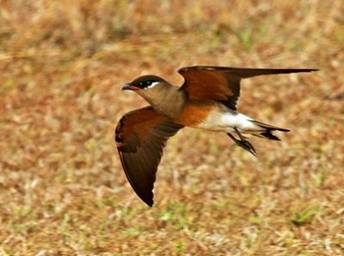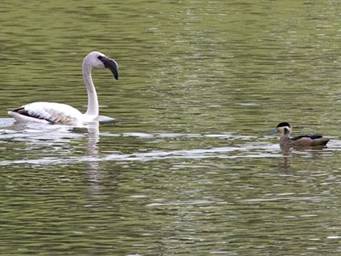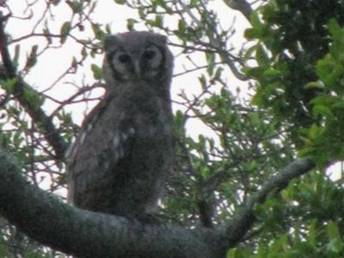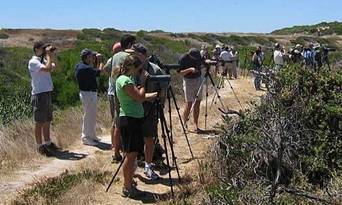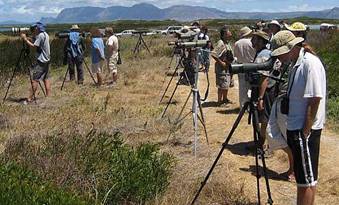SA Rare Bird News Report - 07 October 2010
Trevor Hardaker
|
|
|
|
|
|
|
This is the Southern African Rare Bird News Report issued at 21h15 on Thursday, 07 October 2010. Information has been gleaned from various websites, email groups as well as from individual observers who have passed on their sightings. This report cannot be taken as being totally comprehensive as it is based only on information made available at the time of writing. All bird sightings reported here are reported in good faith based on information as provided by the observers. Any inaccuracies are totally unintentional and the writer cannot be held liable for these. For those who may have only joined the group recently and are interested in finding out what has been seen in the past, previous reports can be viewed at http://groups.google.co.za/group/sa-rarebirdnews |
|
|
|
|
|
I am starting to get a feeling of huge anticipation of what is possibly heading our way! Given the strange local movements of many species at the moment, especially in the Western Cape, I suspect that we may be in for a bumper rarity season. I have been carefully watching what is happening north of us and have been excited to see, firstly, about 2 – 3 weeks ago, the reports coming through from places like Iceland and the Azores of the megas turning up there and then, more recently, the onslaught of brilliant rarities in the UK and Europe, both from the west and east. It seems to be a particularly good season for “yanks” at the moment, especially in the UK, with new mega alerts coming through almost every couple of days. And many of the vagrants turning up there are bound to head south from there, so who knows where they might turn up?! Even if we move on to our own continent, there have been some very interesting records with a YELLOW-LEGGED GULL at Lukuba in Tanzania on Monday being a first record for that country and a very southerly MADAGASCAR PRATINCOLE seen in the Quirimbas National Park in Mozambique (north of the Southern African subregion however!) at the end of last week.
So, please make sure that you have my number (082 780 0376) saved in your phones so that you can let me know immediately (via call or sms) when you do find those real goodies (and then I can pass the news on to the rest of the group timeously so that everyone can have a chance of chasing it) and I hope you have saved up a bit of a “twitching slush fund” for those unexpected, but very exciting, chases as well as a good long list of excuses for why you may have to leave the office early if something turns up during the week! I think you are going to need them… |
|
|
|
|
|
|
|
|
Yellow-legged Gull at Lukuba © Valery Schollaert |
Madagascar Pratincole at Quirimbas NP © David Hoddinott |
|
|
|
|
Alright, so enough of the dreaming and on to some recent local news. Starting in the Western Cape, the irruption of BLACK-HEADED CANARIES on to the west coast continues with individuals of both races being reported from the West Coast National Park and Mauritz Bay this week. Added to this, a single LUDWIG’S BUSTARD was also present near the Seeberg View Point in the WCNP on Tuesday.
Continuing in the province, a group of 12 LESSER FLAMINGOS (very unusual for this area) and a single HOTTENTOT TEAL were located yesterday on a farm dam on the Voor Paardeberg Road that connects the R44 with R302 whilst, across on the eastern side of the province at Knysna, a pair of VERREAUX’S EAGLE OWLS have been showing well over the last few days in a patch of bush along a streamline that comes down from the Sparrebosch Golf Estate. Also, the pair of CUT-THROAT FINCHES first reported visiting a garden in Edgemead in early September (and thought to probably be escapees) are still around and have now been visiting another garden in the same suburb since Tuesday. |
|
|
|
|
|
|
|
|
Lesser Flamingo and Hottentot Teal on Voor Paardeberg Rd © Tertius Gous |
Verreaux’s Eagle Owl in Knysna © Pat Nurse |
|
|
|
|
Moving into the Eastern Cape, a somewhat out of range COMMON SCIMITARBILL has been reported recently from Gorah Elephant Camp in the Addo National Park and would seem to be a particularly good record for the province.
Then into Mpumalanga where the GREEN TWINSPOTS at Skukuza in the Kruger National Park continue to entertain visitors. A male, female and 2 juveniles have been spending most of the last few days feeding in a flowering Weeping Boer-bean in the middle of the western side of the parking area at the shop and are apparently quite confiding at the moment, so well worth a look if you are in the area.
In Limpopo, the THREE-BANDED COURSER reported from near Ngala Tented Camp at the end of September was also still present on Saturday and was seen to be sitting on two eggs.
Heading across into the North-west Province, there was some surprise on the weekend when a VILLAGE WEAVER was caught and ringed near Brits. Ordinarily, this would not be of any surprise except for that fact that the bird appeared to be of the more northerly race Ploceus cucullatus nigriceps which generally occurs from Kenya south to Zimbabwe with the odd individual crossing the border into South Africa and being reported from places like Pafuri in the northern Kruger National Park. From the literature that I have been able to check so far, this may well represent the most southerly record of this race. If anyone knows of more southerly records than this, I would be very interested to hear about these.
Lastly, in Namibia, at least 3 RED-NECKED PHALAROPES were still present at Walvis Bay Salt Works at the end of last week whilst 2 COMMON REDSHANKS were also still on view at Mile 4 Salt Works just north of Swakopmund. |
|
|
|
|
|
|
|
|
Three-banded Courser at Ngala © Wally Davey |
Village Weaver near Brits © Alan Brooks |
|
|
|
|
Don’t forget to send through your details to be included on the various listing clubs that are hosted at www.zestforbirds.co.za. This website also has an extensive rarities gallery that has many additional photos of a number of rarities that are mentioned in these reports. |
|
|
|
|
|
|
|
|
|
|
|
Thank you to all observers who have contributed their records. Please continue to send through any reports of odd birds as well as continued updates on the presence of rarities already previously reported, no matter how mundane you think they may be. Even if you think someone else has probably sent in a report, rather send the report yourself as well. The only way to improve this service and to make it as useful as possible to everyone is if it can be as comprehensive as possible. |
|
|
|
|
|
Kind regards Trevor |
|
|
------------------------------------------------------------------------
TREVOR HARDAKER Cape Town, South Africa
MY WILDLIFE PHOTOS See my photographic attempts at:
ZEST for BIRDS Trevor Hardaker and John Graham Pelagics, rarity photos, listing clubs and more:
SA RARE BIRD NEWS Get the latest rarity news by joining at: http://groups.google.co.za/group/sa-rarebirdnews
SOUTHERN AFRICAN RARITIES Online database of all SA rarities ----------------------------------------------------------------------- |
|
|
|
|



